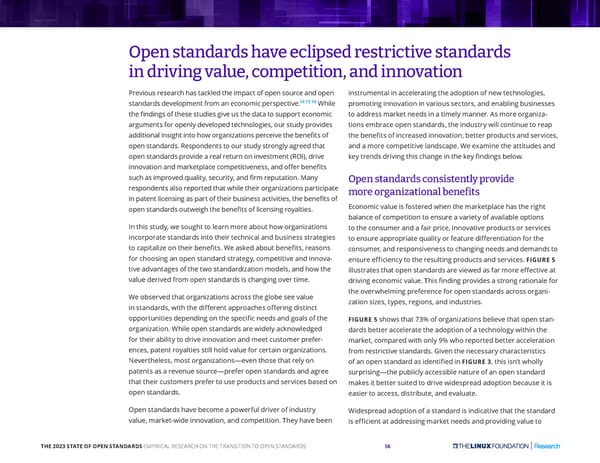Open standards have eclipsed restrictive standards in driving value, competition, and innovation Previous research has tackled the impact of open source and open instrumental in accelerating the adoption of new technologies, 14 15 16 standards development from an economic perspective. While promoting innovation in various sectors, and enabling businesses the findings of these studies give us the data to support economic to address market needs in a timely manner. As more organiza- arguments for openly developed technologies, our study provides tions embrace open standards, the industry will continue to reap additional insight into how organizations perceive the benefits of the benefits of increased innovation, better products and services, open standards. Respondents to our study strongly agreed that and a more competitive landscape. We examine the attitudes and open standards provide a real return on investment (ROI), drive key trends driving this change in the key findings below. innovation and marketplace competitiveness, and offer benefits such as improved quality, security, and firm reputation. Many Open standards consistently provide respondents also reported that while their organizations participate more organizational benefits in patent licensing as part of their business activities, the benefits of open standards outweigh the benefits of licensing royalties. Economic value is fostered when the marketplace has the right balance of competition to ensure a variety of available options In this study, we sought to learn more about how organizations to the consumer and a fair price, innovative products or services incorporate standards into their technical and business strategies to ensure appropriate quality or feature differentiation for the to capitalize on their benefits. We asked about benefits, reasons consumer, and responsiveness to changing needs and demands to for choosing an open standard strategy, competitive and innova- FIGURE 5 ensure efficiency to the resulting products and services. tive advantages of the two standardization models, and how the illustrates that open standards are viewed as far more effective at value derived from open standards is changing over time. driving economic value. This finding provides a strong rationale for We observed that organizations across the globe see value the overwhelming preference for open standards across organi- in standards, with the different approaches offering distinct zation sizes, types, regions, and industries. opportunities depending on the specific needs and goals of the FIGURE 5 shows that 73% of organizations believe that open stan- organization. While open standards are widely acknowledged dards better accelerate the adoption of a technology within the for their ability to drive innovation and meet customer prefer- market, compared with only 9% who reported better acceleration ences, patent royalties still hold value for certain organizations. from restrictive standards. Given the necessary characteristics Nevertheless, most organizations—even those that rely on FIGURE 3, this isn’t wholly of an open standard as identified in patents as a revenue source—prefer open standards and agree surprising—the publicly accessible nature of an open standard that their customers prefer to use products and services based on makes it better suited to drive widespread adoption because it is open standards. easier to access, distribute, and evaluate. Open standards have become a powerful driver of industry Widespread adoption of a standard is indicative that the standard value, market-wide innovation, and competition. They have been is efficient at addressing market needs and providing value to THE 2023 STATE OF OPEN STANDARDS EMPIRICAL RESEARCH ON THE TRANSITION TO OPEN STANDARDS 16
 The 2023 State of Open Standards Page 15 Page 17
The 2023 State of Open Standards Page 15 Page 17